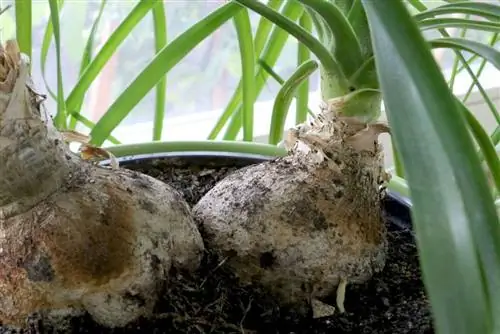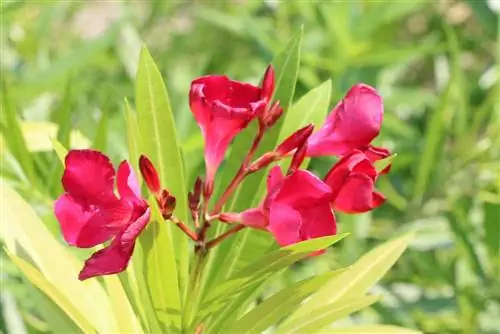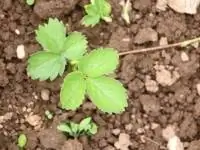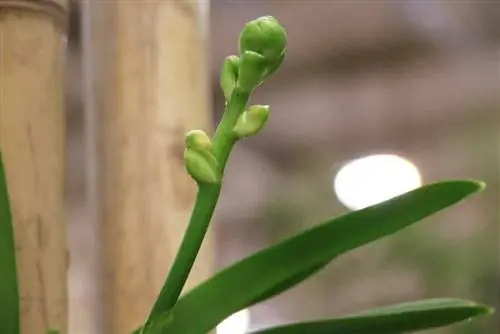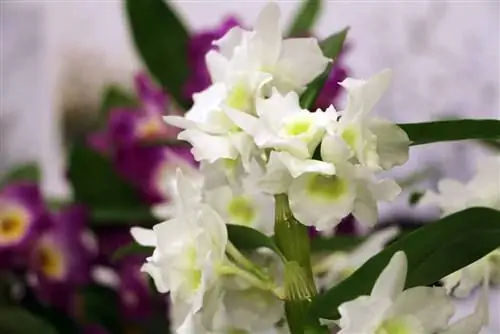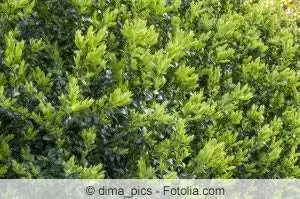- Author admin [email protected].
- Public 2023-12-17 03:39.
- Last modified 2025-01-24 12:45.
The elephant's foot is an exotic plant that is grown in pots in our latitudes. The tree proves to be robust and easy to care for. It reaches heights of up to 1.5 meters indoors. In summer the elephant foot can be placed outside. It comes from Mexico and loves warm, bright locations.
Growth and appearance
The special thing about the elephant's foot is a clearly visible thickening at the lower end of the trunk. It gives the plant its figurative name. The barky trunk of the elephant's foot bulges like a balloon at its base. The plant stores water there, which is why it is also called the bottle tree. The crown of the tree consists of an umbrella-like tuft with loosely hanging, long, narrow green leaves. The exotic tree, which comes from Mexico, reaches heights of up to 9 meters as an outdoor plant in its homeland and can live 100 years. Even as a houseplant, the elephant's foot often lasts for several decades, although its size in the pot is much smaller.
Special location requirements
Due to its origins in the hot regions of Mexico, the elephant's foot loves a climate similar to that found in deserts. He strives for a place in the sun with full incidence of light. A lack of light results in a reduction in its already low growth speed. The elephant's foot only grows a few centimeters a year. It does not tolerate drafts as it naturally grows in windless locations. In summer it feels comfortable in great warmth. The higher the temperatures climb, the better it grows. However, especially with young plants, there is a risk that the leaves will burn in the blazing midday sun. Therefore, the tree should be protected at midday by blinds, curtains or plants that cast shade.
Ideal location conditions for optimal growth
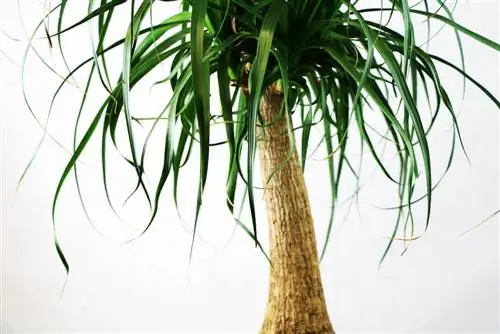
Since the elephant's foot is mobile in the pot, you can gradually accustom it to the brighter sun in its outdoor summer location. First place the plant in a little shade and gradually move it more and more into the sun. This allows the leaf crown to adapt well to the bright sunlight and grow optimally. If a second leaf crown, i.e. a secondary shoot, forms, it is an offshoot. This can be used to propagate the plant. A second elephant foot can be grown from the side shoot.
Flowers and seeds
An elephant's foot grown as a pot plant only rarely produces seeds. Plants that grow in their natural habitat in the wild develop long panicles with small, white flowers. Potted plants grown in our latitudes only bloom if they are in very favorable locations and have optimal climatic conditions with lots of sun without air movement. Even then, it takes many years for flowers to appear for the first time. That's why it's only possible very rarely and with a lot of luck to get seeds from a home-grown elephant's foot. Accordingly, it is hardly possible to propagate an elephant foot from home-grown seeds.
This is how you can propagate with an offshoot
However, an offshoot is more often formed from a potted plant. The plant must have been growing for a few years to form an offshoot, but then side shoots are no longer uncommon. With the right procedure, it is no problem to grow a new elephant foot from a cutting of the old plant.
Promote the development of side shoots
Before a side shoot grows on an elephant's foot, it must have reached a trunk height of at least 20 cm. An elephant's foot can be this size when it is three to four years old. A sufficiently large pot has an optimal effect on the growth of the plant. However, if the pot is too large, the plant will concentrate too much on developing new roots and will only grow slightly above the ground. That's why it's better to put them in a larger pot every four years instead of choosing a large pot right away. The new pot should always be only a few centimeters larger than the previous pot.
The right time
Repotting should take place in early spring, ideally between the end of February and mid-March. In addition, the growth and formation of side shoots can be stimulated by pruning the trunk. The best time to start propagating elephant foot through offshoots is summer. Then the offshoots are strong and resilient enough to be separated from the mother plant and grow independently. In addition, the constant soil heat needed to form new roots is easy to ensure in summer.
The accessories you need
Before you start propagating the elephant foot with an offshoot, you should have the following accessories ready:
- loose potting soil
- a flower pot
- a transparent cover or transparent covering film
- a container with water
- a small bottle of liquid fertilizer
- a sharp, disinfected knife
The substrate
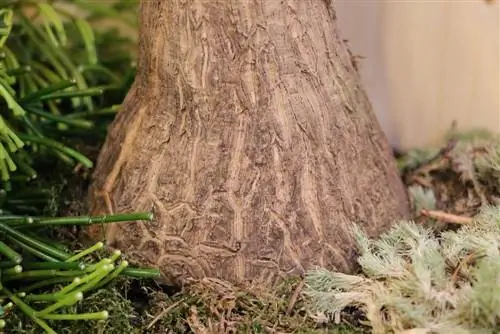
The potting soil ideally consists of sand and peat, in a mixing ratio of 1:2. The bottle tree tolerates calcareous soil. A pH value between 5.8 and 6.8 is optimal. What is important is that the soil is loose and permeable. In addition to a peat-sand mixture, permeable cactus soil or a mixture of humus-rich leaf mold and sand are also suitable.
How to get a cutting that can be used as a cutting
If a he althy new side shoot has formed on the leaf axils of an elephant's foot, the leaves of which are about 15 cm long, you can cut it off with a knife directly above the trunk so that there is still a piece of wood at the lower end located. The leaves can then be shortened to around 5 cm.
Instructions
Prepare a small flower pot no more than 10 cm high with loose, moistened potting soil, because the elephant's foot is a shallow-rooted plant. Now you can insert the shortened offshoot with the hard, woody lower end about 5 cm deep into the substrate. Then press the soil around the cutting so that it stands upright in the pot. Now you can put the cover over the cutting. This is how you create a greenhouse climate. This whiteness keeps the moisture in the pot, which promotes rooting.
Caring for the new young plant
Once roots have formed, you can remove the hood to acclimate the plant to the drier surrounding air. In order for it to develop well, the young plant needs a warm, bright location with sunlight in the morning or evening. However, their leaves must be protected from the hot midday sun. After removing the cover, the plant needs moderate watering. Because of its water-storing properties, it only requires a small amount of irrigation water.
Economical use of water and fertilizer
There should be holes in the bottom of the pot to allow excess water to drain away. Waterlogging can lead to root damage. After about 6 weeks, the nutrients in the substrate are used up. The plant can then be given some liquid fertilizer every three to four weeks until the end of the growth phase in October. In winter, the ambient temperature of the elephant's foot should not fall below 10 degrees Celsius.
Propagation of cuttings in 7 steps
- Cut off the side shoots close to the trunk of the plant
- fill a small pot with loose substrate
- Place cuttings in the substrate and carefully press soil firmly
- Water the sprout lightly or spray with water so that the soil is moist but not wet
- Put a cellophane bag or clear plastic cover over the cutting to create a greenhouse climate with constant soil heat and minimal moisture loss
- As soon as roots have formed and new leaves appear, remove the hood or bag
- water moderately, fertilize during the growth phase

